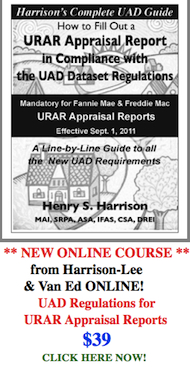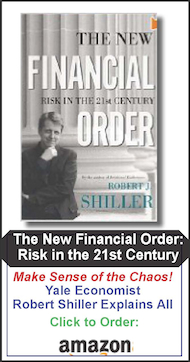Sound Off
12/17/10 Categories: Sound Off
RE: Fannie Mae Article in Fall 2010 REV
Dear Henry & The Editor,
Regarding your short article on the need for Fannie Mae & Freddie Mac. The following quote was from your article:
“From before the end of World War II, it was axiomatic in the minds of most Americans and reflected in the thinking of Congress and the various Presidential Administrations (both Republican and Democratic) that rising home ownership was desirable.”
“These people choose to ignore the two major problems caused by homeownership: the lack of mobility of the labor force at a time when moving was often the best way to get a new job; and the high use of energy caused by suburban living (large inefficient houses and excessive use of automobiles).”
I think this reasoning is incomplete insofar as it does not delve deep enough into the rationale that grew up around the home ownership bandwagon.
After years of decline, many urban planners began to see that their forays into social engineering in many urban neighborhoods had led to disaster. This was evident in many cities, but in New York especially. Sometimes the reason for the decay outgrew from good intentions or improvements that were deemed beneficial despite certain consequences. The construction of the Cross Bronx Expressway in the Bronx by Robert Moses was a case in point. There was a definite need for a cross county corridor extension of interstate 95 from NJ to other northeast states. Given the location of the GW Bridge built in the 1930’s, a stretch from the west to the northeast end of the Bronx made perfect sense. However, one of the unintended consequences of bisecting the borough was to effectively cut certain, vibrant neighborhoods in half, thereby constricting the unfettered flow of people and commerce between both sides of a now in place expressway. The unintended consequence? A little more than a decade later with urban flight exacerbated by the road divide, you had a bombed out south Bronx reminiscent of Berlin after the bombings it sustained in WWII.
A microcosm of the malaise that home ownership sought to combat can be seen from what generally happened in urban areas after WWII. After the war, the population of the country started to blossom. The Great Depression was a distant memory and America was revitalized as a manufacturing giant due to the war effort. Population growth was especially acute in urban areas and eventually spread to surrounding suburban locales. As the demographics in urban areas changed, so did the social profile and a concomitant need for additional housing. Many cities like New York built extensive projects to house this new demographic. At the same time the concentration of the less affluent in these areas exacerbated the urban flight by the post WWII generation. Neighborhoods once filled with law-abiding immigrants now began to disintegrate leaving a growing core of a poorer class in its wake. Within a short period of time, the new projects became bastions for increased crime and drug trafficking. One only had to walk through the interior halls of many of these project buildings to see the degradation sprayed on the walls. Urine smelling elevators, dimly lit hallways, graffiti laden walls – all gave a picture of defilement. City planners even coined a name for it, calling it “urban decay”.
This blight did not stop with real estate. It also extended to the families that occupied these areas. After a couple of decades of this deterioration and its debilitating effect on the esteem of all those concerned, city planners in league with legislators reasoned that if families living in these circumstances were given an opportunity to “own” their own residence, this might improve self-esteem and engender a sense of responsibility an observed byproduct of ownership. This, in turn, would arrest further deterioration and might eventually lead to a revitalization of areas and an attraction of private capital for new development and gentrification.
The goal was a worthy one and it did have the desired effect of revitalizing entire neighborhoods through various home ownership programs. However, at some point, what was an admirable goal morphed into a no-one-is-refused free-for-all for home ownership and equity refinancing encouraged by low interest rates and an overall easing of loan qualifications. Thrown into this mix was the emergence of what was to become an insatiable appetite for mortgage securitization by Wall Street and the entire process went haywire (no-doc loans, ARMS with teaser rates, etc.) in an effort to multiply fee and bonus income.
In response to the point in your article, job mobility was not really the issue as seen from the above. As long as prices were generally rising (and they were), selling one’s residence to move was not an issue. It is an issue today because equity values have been wiped out in many cases and home values are below the level of mortgage indebtedness making refinancing impossible. Nor was high energy usage a major factor at the time.
Peter von Nessi, CSA-G
Certified General Appraiser
Bronx, NY 10465
normandygroup@optonline.net
Editor's Note: There is currently a movement away from the MacMansions, Hummers and giant SUVs of the previous decade, even among those who can afford them. We agree that this is not primarily due to the expense of fuel. In our "greener" times, more people are concerned about their impact on the environment, and some are even prepared to make lifestyle changes to help mitigate it.
Dear Henry & The Editor,
Regarding your short article on the need for Fannie Mae & Freddie Mac. The following quote was from your article:
“From before the end of World War II, it was axiomatic in the minds of most Americans and reflected in the thinking of Congress and the various Presidential Administrations (both Republican and Democratic) that rising home ownership was desirable.”
“These people choose to ignore the two major problems caused by homeownership: the lack of mobility of the labor force at a time when moving was often the best way to get a new job; and the high use of energy caused by suburban living (large inefficient houses and excessive use of automobiles).”
I think this reasoning is incomplete insofar as it does not delve deep enough into the rationale that grew up around the home ownership bandwagon.
After years of decline, many urban planners began to see that their forays into social engineering in many urban neighborhoods had led to disaster. This was evident in many cities, but in New York especially. Sometimes the reason for the decay outgrew from good intentions or improvements that were deemed beneficial despite certain consequences. The construction of the Cross Bronx Expressway in the Bronx by Robert Moses was a case in point. There was a definite need for a cross county corridor extension of interstate 95 from NJ to other northeast states. Given the location of the GW Bridge built in the 1930’s, a stretch from the west to the northeast end of the Bronx made perfect sense. However, one of the unintended consequences of bisecting the borough was to effectively cut certain, vibrant neighborhoods in half, thereby constricting the unfettered flow of people and commerce between both sides of a now in place expressway. The unintended consequence? A little more than a decade later with urban flight exacerbated by the road divide, you had a bombed out south Bronx reminiscent of Berlin after the bombings it sustained in WWII.
A microcosm of the malaise that home ownership sought to combat can be seen from what generally happened in urban areas after WWII. After the war, the population of the country started to blossom. The Great Depression was a distant memory and America was revitalized as a manufacturing giant due to the war effort. Population growth was especially acute in urban areas and eventually spread to surrounding suburban locales. As the demographics in urban areas changed, so did the social profile and a concomitant need for additional housing. Many cities like New York built extensive projects to house this new demographic. At the same time the concentration of the less affluent in these areas exacerbated the urban flight by the post WWII generation. Neighborhoods once filled with law-abiding immigrants now began to disintegrate leaving a growing core of a poorer class in its wake. Within a short period of time, the new projects became bastions for increased crime and drug trafficking. One only had to walk through the interior halls of many of these project buildings to see the degradation sprayed on the walls. Urine smelling elevators, dimly lit hallways, graffiti laden walls – all gave a picture of defilement. City planners even coined a name for it, calling it “urban decay”.
This blight did not stop with real estate. It also extended to the families that occupied these areas. After a couple of decades of this deterioration and its debilitating effect on the esteem of all those concerned, city planners in league with legislators reasoned that if families living in these circumstances were given an opportunity to “own” their own residence, this might improve self-esteem and engender a sense of responsibility an observed byproduct of ownership. This, in turn, would arrest further deterioration and might eventually lead to a revitalization of areas and an attraction of private capital for new development and gentrification.
The goal was a worthy one and it did have the desired effect of revitalizing entire neighborhoods through various home ownership programs. However, at some point, what was an admirable goal morphed into a no-one-is-refused free-for-all for home ownership and equity refinancing encouraged by low interest rates and an overall easing of loan qualifications. Thrown into this mix was the emergence of what was to become an insatiable appetite for mortgage securitization by Wall Street and the entire process went haywire (no-doc loans, ARMS with teaser rates, etc.) in an effort to multiply fee and bonus income.
In response to the point in your article, job mobility was not really the issue as seen from the above. As long as prices were generally rising (and they were), selling one’s residence to move was not an issue. It is an issue today because equity values have been wiped out in many cases and home values are below the level of mortgage indebtedness making refinancing impossible. Nor was high energy usage a major factor at the time.
Peter von Nessi, CSA-G
Certified General Appraiser
Bronx, NY 10465
normandygroup@optonline.net
Editor's Note: There is currently a movement away from the MacMansions, Hummers and giant SUVs of the previous decade, even among those who can afford them. We agree that this is not primarily due to the expense of fuel. In our "greener" times, more people are concerned about their impact on the environment, and some are even prepared to make lifestyle changes to help mitigate it.






















